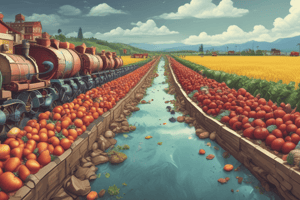Podcast
Questions and Answers
During the early times in the 5th century, abbeys and royal households are common places that practice quantity food production. Although both places are different from what we know today, each of these places contributed to the practices of the present-day ______.
During the early times in the 5th century, abbeys and royal households are common places that practice quantity food production. Although both places are different from what we know today, each of these places contributed to the practices of the present-day ______.
foodservice
Abbeys in the countryside of England serve not just several brethren of the order but also thousands of ______ during seasons of worship.
Abbeys in the countryside of England serve not just several brethren of the order but also thousands of ______ during seasons of worship.
pilgrims
The scale of their foodservice operations can be seen in the space they allot for their foodservice preparations; the more brethren of the order they cater and ______ that pass by, the larger space they provide for their kitchen.
The scale of their foodservice operations can be seen in the space they allot for their foodservice preparations; the more brethren of the order they cater and ______ that pass by, the larger space they provide for their kitchen.
pilgrims
According to records, food preparation in the abbeys are of much higher standards than the food served in the inns; these records also show that there is a strong sense of stewardship in the abbeys and that they have created an effective early-day ______ accounting system.
According to records, food preparation in the abbeys are of much higher standards than the food served in the inns; these records also show that there is a strong sense of stewardship in the abbeys and that they have created an effective early-day ______ accounting system.
Signup and view all the answers
The royal households serve hundreds of people, both monarchs and servants, each meal. They serve different ranks of individuals with different food allowances so they have developed strict ______ accounting methods that marked the beginning of the present-day scientific cost accounting.
The royal households serve hundreds of people, both monarchs and servants, each meal. They serve different ranks of individuals with different food allowances so they have developed strict ______ accounting methods that marked the beginning of the present-day scientific cost accounting.
Signup and view all the answers
There are often two kitchens that prepare food for different ranks; the cuisine de bouche prepares food for monarchs, principal courtiers, officials, and immediate servants; the other one is the cuisine de commun which provides food for the rest of the ______.
There are often two kitchens that prepare food for different ranks; the cuisine de bouche prepares food for monarchs, principal courtiers, officials, and immediate servants; the other one is the cuisine de commun which provides food for the rest of the ______.
Signup and view all the answers
What was a significant contribution of abbeys to present-day foodservice practices?
What was a significant contribution of abbeys to present-day foodservice practices?
Signup and view all the answers
What distinguishes the food served in the abbeys from that served in inns?
What distinguishes the food served in the abbeys from that served in inns?
Signup and view all the answers
Why did royal households develop strict cost accounting methods for their foodservice operations?
Why did royal households develop strict cost accounting methods for their foodservice operations?
Signup and view all the answers
What were the two types of kitchens found in royal households?
What were the two types of kitchens found in royal households?
Signup and view all the answers
What is a common feature between abbeys and royal households regarding food preparation?
What is a common feature between abbeys and royal households regarding food preparation?
Signup and view all the answers
What set the abbeys apart from inns in terms of foodservice quality?
What set the abbeys apart from inns in terms of foodservice quality?
Signup and view all the answers
Why did abbeys provide larger kitchen space as more brethren of the order and pilgrims passed by?
Why did abbeys provide larger kitchen space as more brethren of the order and pilgrims passed by?
Signup and view all the answers
What role did royal households play in the development of cost accounting methods?
What role did royal households play in the development of cost accounting methods?
Signup and view all the answers
Which group received food prepared by Cuisine de bouche in royal households?
Which group received food prepared by Cuisine de bouche in royal households?
Signup and view all the answers
What was a characteristic feature of abbeys' early-day cost accounting system?
What was a characteristic feature of abbeys' early-day cost accounting system?
Signup and view all the answers




